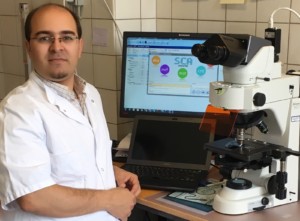Better sperm motility and kinematics after short vs. long ejaculatory abstinence
It has long been observed that semen volume, sperm concentration and total sperm counts increase with increasing duration of abstinence; However, recent studies suggest that there is a paradoxical improvement of sperm motility and kinematic parameters with shorter abstinence periods.

Hiva Alipour (D.V.M, PhD)
Our recent study (Alipour et al. 2017) characterized the intra-individual differences in the sperm motility and kinematic parameters of semen samples from normozoospermic men collected after seven days versus two hours of ejaculatory abstinence by using a computer-aided sperm analysis system. As expected, semen volume and sperm concentrations were lower in ejaculates obtained after shorter versus longer abstinence. However, semen samples obtained after only two hours of abstinence demonstrated better kinematic parameters including higher percentages of rapid sperm velocity and hyperactived sperm, which can in turn affect the sperm zona penetration ability. Moreover, samples obtained after only 2 hours of abstinence had higher average velocity values and progressive swimming path parameters, compared with those obtained after four to seven days.
Another recent study on oligozoospermic patients (Bahadur et al. 2016) also demonstrated similar results with better sperm motility and also better sperm counts in sub-fertile male with abstinence periods of as low as 30 minutes after the first.
Therefore, using samples obtained after a short abstinence period may allow for a simpler method to select high-quality spermatozoa, which could prove to be an advantage for ART (advanced reproductive technology) procedures such as conventional IVF or ICSI, where a large number of spermatozoa is not required.
The results of these studies question the current routinely recommended abstinence periods before semen collection for diagnostic or treatment purposes, and point out the need for a reevaluation of the current strategies used in the assessment and management of potential male subfertility.
Hiva Alipour (D.V.M., PhD.)
Postdoctoral fellow (Department of Health Science and Technology, Aalborg University, Denmark)
Consultant, Scientific specialist (Microptic S.L.)
Sources:
Alipour, H., Van Der Horst, G., Christiansen, O. B., Dardmeh, F., Jørgensen, N., Nielsen, H. I., & Hnida, C. (2017). Improved sperm kinematics in semen samples collected after 2 h versus 4–7 days of ejaculation abstinence. Human Reproduction, 32(7), 1364–1372. https://doi.org/10.1093/humrep/dex101
Bahadur, G., Almossawi, O., Zaid, Z., Ilahibuccus, A., Al-Habib, A., Muneer, A., & Okolo, S. (2015). Semen characteristics in consecutive ejaculates with short abstinence in subfertile males. Reproductive BioMedicine Online, 32(3), 323–328. https://doi.org/10.1016/j.rbmo.2015.11.021



Leave A Comment